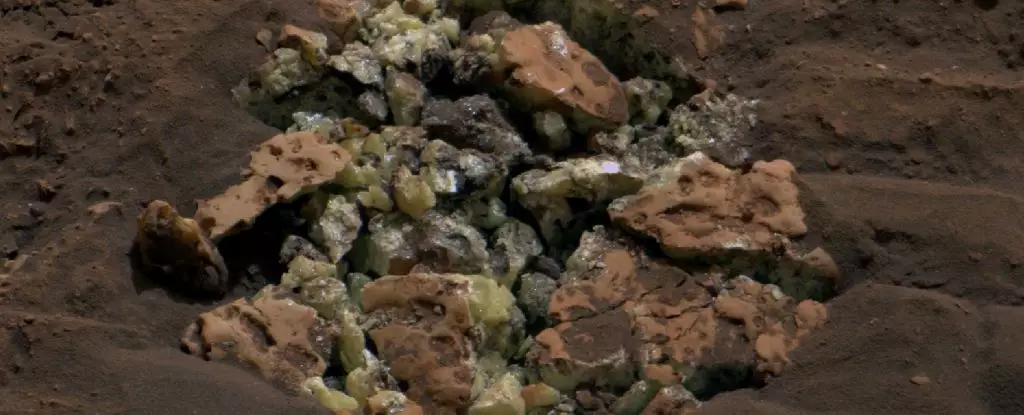Mars has long been a captivating enigma for scientists and space enthusiasts alike. For decades, our curiosity about its surface chemistry, geological history, and potential habitability has driven relentless exploration missions. Recently, a remarkable discovery by NASA’s Curiosity rover has challenged many assumptions and opened new avenues of inquiry. When Curiosity’s rover inadvertently cracked open a seemingly unassuming rock in the Gediz Vallis Channel, it revealed a startling deposit of pure elemental sulfur— a find that could reshape our understanding of Martian geology and its past environmental conditions. Unlike the common sulfate minerals typically encountered on Mars, this deposit of brimstone points to complex processes that might have taken place in Mars’s distant past, processes we haven’t yet fully grasped.
The Significance of Finding Elemental Sulfur on Mars
The discovery of sulfur in its elemental form is groundbreaking. Sulfates, which are sulfate minerals formed through aqueous processes, have been extensively documented on Mars, offering clues about water activity and climate history. Yet elemental sulfur—orange-yellow crystals—had remained elusive until now. Its presence raises provocative questions: How did the sulfur arrive here in such a pure form? What geological or chemical mechanisms could have fostered its formation? Importantly, this wasn’t a localized anomaly but appeared to be part of a broader sulfur-rich landscape, hinting at the possibility of large sulfur deposits in Gale Crater’s vicinity.
The fact that sulfur is essential for life, forming a core component of amino acids, adds further intrigue. While current data does not suggest signs of present or past life, it fuels the hypothesis that Mars might have harbored the chemical ingredients necessary for microbial life at some point. The elemental sulfur deposit thus becomes both a geological curiosity and a tantalizing hint about Mars’s biological potential.
Challenging Existing Geological Models
Most planetary scientists have long believed that sulfur on Mars primarily exists in mineral forms—compounds created through water-rock interactions and subsequent evaporation. The presence of pure sulfur suggests that the planet’s geological history may be more dynamic than previously thought. For pure sulfur to have accumulated naturally, certain conditions are necessary—conditions that are not easily explained by current models. One possibility is volcanic activity or thermal processes that could have caused sulfur to be released and then crystallized in specific regions. Alternatively, microbial activity, though speculative, cannot be dismissively ruled out in the extraterrestrial context.
The discovery also casts doubt on the simplicity of Mars’s evaporation and weathering history. It indicates that sulfur cycling, chemical transformations, or perhaps even transient environmental conditions may have created niche habitats capable of producing or preserving such deposits. The challenge for scientists is to interpret these findings within the puzzle of Mars’s overall geological narrative, emphasizing the need for more sophisticated models that account for episodic, rather than solely continuous, processes.
The Future of Martian Exploration and the Search for Secrets
This accidental discovery underscores the importance of mobility and serendipity in planetary exploration. Had Curiosity not happened to roll over that particular rock, the sulfur deposit might have gone unnoticed for years. It speaks volumes about the value of close-up analysis and the need for adaptive strategies in rover missions. Moving forward, scientists are eager to explore whether similar deposits exist elsewhere on Mars—possibly across broader regions—and what their distribution tells us about past environmental conditions.
The next steps involve detailed chemical and mineralogical analyses coupled with advanced modeling of Mars’s geological history. Future missions, perhaps robotic or human, could focus on targeted excavation or sampling in these sulfur-rich areas to unlock even deeper secrets about the planet’s past. Additionally, this discovery fuels the argument for deploying more sensitive instruments capable of detecting elemental compounds directly in the field, reducing our dependency on opportunistic findings like this one.
In the grand scheme, the discovery of pure sulfur on Mars reminds us that planetary exploration is as much about surprises as it is about confirming hypotheses. Each new find complicates our narrative but also enriches it—adding depth and nuance to our understanding of our neighboring world. As Curiosity continues its journey, the Martian landscape appears increasingly complex and inviting, promising more revelations that could reshape our conception of planetary processes, habitability, and perhaps even the origins of life itself.


Leave a Reply